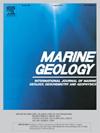Formation of vertical columnar seismic structures and seafloor depressions by groundwater discharge in the drowned Miami Terrace platform and overlying deep-water carbonates, southeastern Florida
IF 2.6
3区 地球科学
Q2 GEOSCIENCES, MULTIDISCIPLINARY
引用次数: 0
Abstract
The presence of vertical cross-formational fluid migration passageways within sedimentary basins can profoundly impact aquifer and reservoir fluid-flow and their identification is fundamental to informing management of subsurface fluid resources (groundwater, oil, gas). In an onshore and offshore southeastern part of Florida, 2D/3D seismic-reflection and bathymetry data document ∼153 vertical columnar structures composed of reflection disruptions up to 790 m in the height and averaging 360 m in diameter, and ∼219 subcircular to circular seafloor depressions up to 1334 m wide. Our study focuses on these features found within the offshore shallow-marine carbonate Miami Terrace platform, which drowned approximately at the end of the middle Miocene, and within overlying Plio-Quaternary deep-water carbonate slope and drift deposits. Most columnar structures are rooted in stratiform aquifers of the Miami Terrace platform and associated with faults or fault intersections produced by Eocene and circa late Miocene tectonics. The columns commonly terminate within the platform or as subcircular depressions along an amalgamated karstic and drowning unconformity at the platform top. The columns typically stretch upwards from a zone of deep karst cavity collapse through the Miami Terrace platform with upward decreasing sag on internal reflections. Following drowning and Plio-Quaternary partial burial of the Miami Terrace platform by deep-water deposits, the subcircular depressions and faults along the platform top were points of origin for a second phase of column growth upward into the deep-water deposits. The continuation of deep platform cavity collapse and column evolution produced pockmarks along paleo-seafloors within the deep-water deposits and at the present-day sea floor. The Plio-Quaternary pockmarks formed at water depths too deep to suggest an origin related to meteoric karst above or near sea level, but rather their formation is suggested to be related to cyclic sea level falls that drove increased groundwater head and density gradients, and seafloor discharge of offshore freshened groundwater sourced from the underlying platform. Plausibly, mixing of freshened groundwater and seawater at the seafloor discharge sites drove dissolution of the host deep-water deposits, which together with erosion by groundwater venting and current scouring formed the pockmarks.
Seaward of the Plio-Quaternary seafloor pockmarks, at the late-middle Miocene upper slope of the Miami Terrace platform and along the regional karst/drowning unconformity is a slope-parallel band of ∼189 densely distributed subcircular seafloor depressions with diameters up to 1334 m at water depths up to ∼660 m. It is plausible that along the upper slope, faults and fractures produced by gravity-driven slope instability and possibly tectonics formed a dense network of fluid passageways that promoted upward artesian freshened groundwater flow to sites of discharge where mixing with seawater generated limestone dissolution and the depressions. But tectonic uplift may have forced emersion and initial meteoric sinkhole formation circa late Miocene with later enhancement by freshened groundwater discharge and bottom current erosion.
佛罗里达州东南部淹没的迈阿密台地平台和上覆深水碳酸盐岩中地下水排放形成的垂直柱状地震结构和海底洼地
沉积盆地内存在的垂直跨构造流体迁移通道会对含水层和储层流体流动产生深远影响,识别这些通道对地下流体资源(地下水、石油、天然气)的管理至关重要。在佛罗里达州东南部的陆上和近海地区,二维/三维地震反射和水深测量数据记录了 153 个垂直柱状结构,这些结构由高度达 790 米、平均直径 360 米的反射断层和 219 个宽达 1334 米的亚圆形至圆形海底凹陷组成。我们的研究主要集中在近海浅海碳酸盐迈阿密台地(大约在中新世末期淹没)以及上覆的第四纪深水碳酸盐斜坡和漂移沉积层中发现的这些地貌。大多数柱状结构植根于迈阿密台地平台的层状含水层中,并与始新世和大约中新世晚期构造产生的断层或断层交汇处有关。岩柱通常在平台内终止,或在平台顶部沿着喀斯特和溺水不整合地层形成亚圆形凹陷。岩柱通常从深层岩溶洞穴塌陷区向上延伸,穿过迈阿密台地平台,内部反射向上递减下陷。在迈阿密台地平台被淹没和第四纪深水沉积部分掩埋之后,沿平台顶部的次圆形凹陷和断层成为第二阶段岩柱向上生长进入深水沉积的起点。平台深腔塌陷和岩柱演化的延续在深水沉积层内和今天的海底沿古海底形成了麻点。上第四纪麻子痕形成的水深太深,不足以说明其起源与海平面以上或附近的陨石岩溶有关,而是认为其形成与海平面周期性下降有关,海平面下降导致地下水水头和密度梯度增大,来自底层平台的近海淡化地下水在海底排出。在海底排放点,淡化的地下水与海水混合,推动了主深水沉积物的溶解,再加上地下水喷涌和海流冲刷的侵蚀,形成了麻子坑。在迈阿密台地平台的中新世晚期上坡和区域岩溶/溺水不连续面上,上新世-第四纪海底麻子的向海方向是一条与坡面平行的带状区域,其中有 189 个密集分布的近圆形海底洼地,直径达 1334 米,水深达 660 米。有理由认为,沿斜坡上部,由重力驱动的斜坡不稳定性和可能的构造作用产生的断层和裂缝形成了密集的流体通道网络,促进自流淡化的地下水向上流到排泄点,与海水混合产生石灰岩溶解和洼地。但是,构造隆起可能在大约中新世晚期迫使水流涌出并形成了最初的流星沉井,后来又因淡化的地下水排放和底流侵蚀而得到加强。
本文章由计算机程序翻译,如有差异,请以英文原文为准。
求助全文
约1分钟内获得全文
求助全文
来源期刊

Marine Geology
地学-地球科学综合
CiteScore
6.10
自引率
6.90%
发文量
175
审稿时长
21.9 weeks
期刊介绍:
Marine Geology is the premier international journal on marine geological processes in the broadest sense. We seek papers that are comprehensive, interdisciplinary and synthetic that will be lasting contributions to the field. Although most papers are based on regional studies, they must demonstrate new findings of international significance. We accept papers on subjects as diverse as seafloor hydrothermal systems, beach dynamics, early diagenesis, microbiological studies in sediments, palaeoclimate studies and geophysical studies of the seabed. We encourage papers that address emerging new fields, for example the influence of anthropogenic processes on coastal/marine geology and coastal/marine geoarchaeology. We insist that the papers are concerned with the marine realm and that they deal with geology: with rocks, sediments, and physical and chemical processes affecting them. Papers should address scientific hypotheses: highly descriptive data compilations or papers that deal only with marine management and risk assessment should be submitted to other journals. Papers on laboratory or modelling studies must demonstrate direct relevance to marine processes or deposits. The primary criteria for acceptance of papers is that the science is of high quality, novel, significant, and of broad international interest.
 求助内容:
求助内容: 应助结果提醒方式:
应助结果提醒方式:


